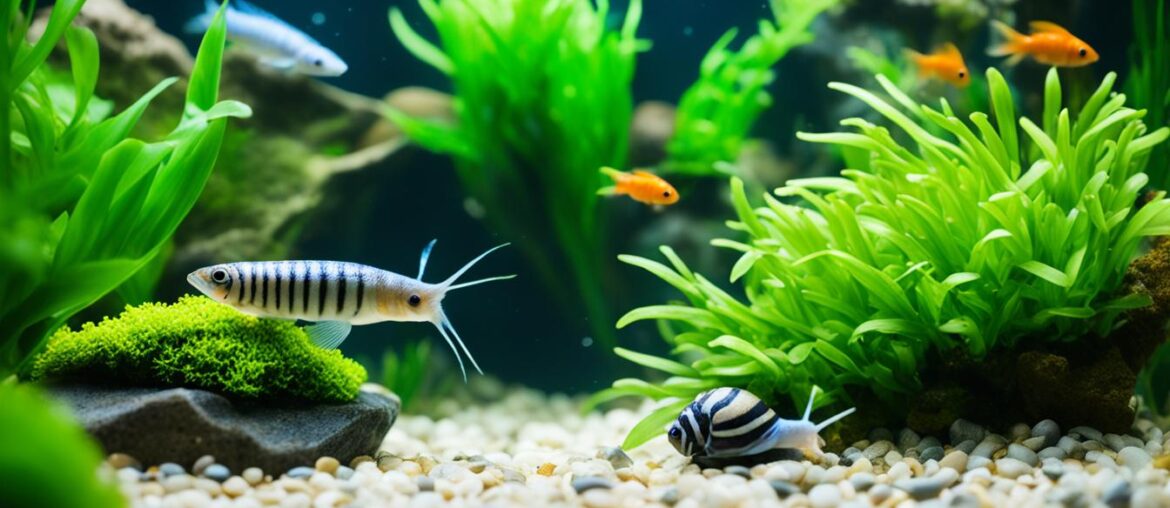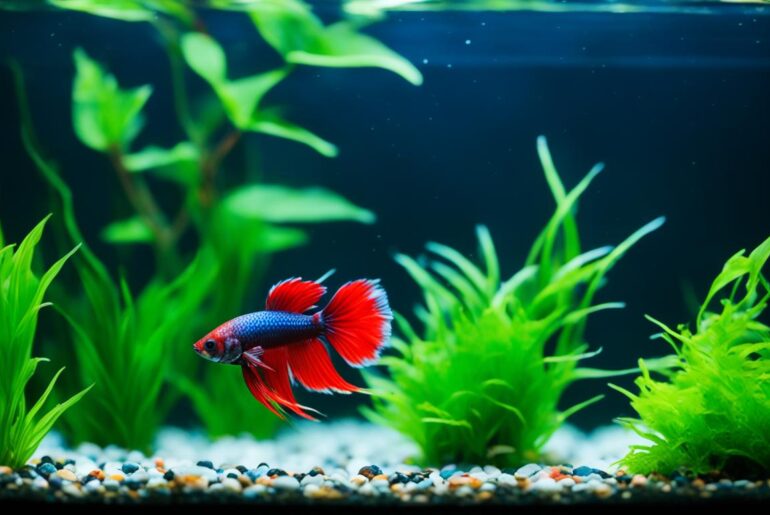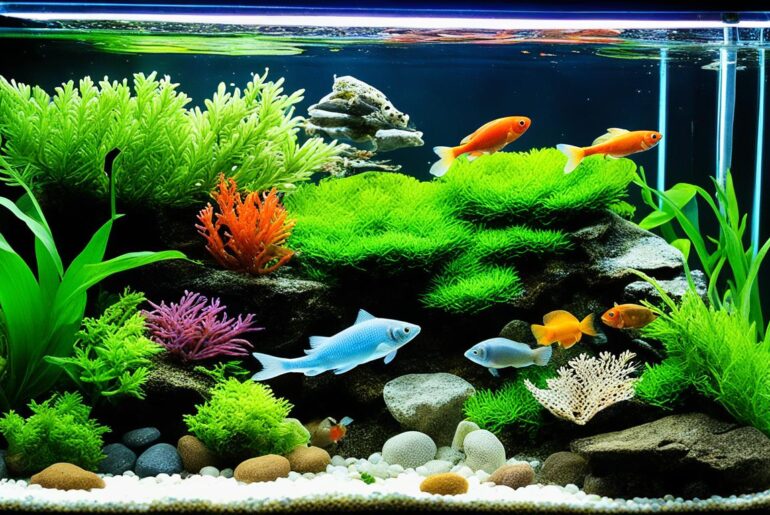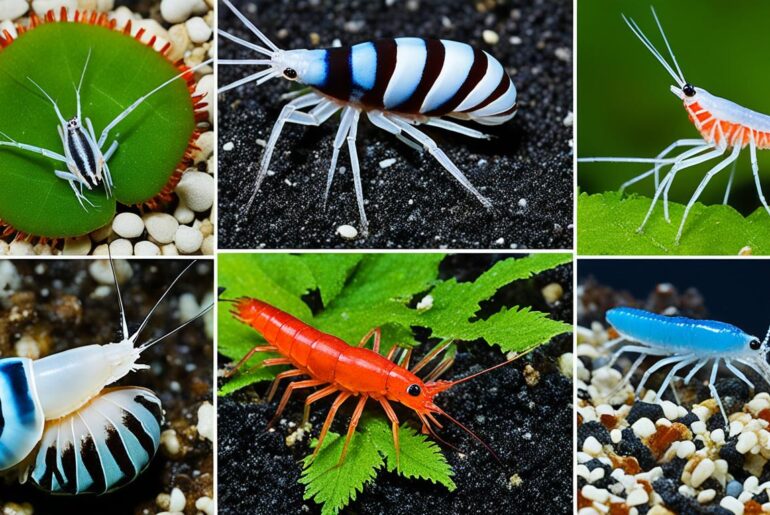The importance of having algae control in your aquarium cannot be underestimated. Algae can quickly turn your underwater world into an unsightly mess, affecting the health and appearance of your fish tank. To tackle this issue, it’s essential to have the right algae-eating invertebrates in your aquarium. In this article, we will explore the top 7 freshwater invertebrates that excel at algae control, providing a clean and healthy environment for your fish.
Key Takeaways:
- Choose the right algae-eating invertebrates for effective algae control in your freshwater aquarium.
- Algae can quickly become a problem in your fish tank, affecting the health and appearance of your fish.
- The top 7 freshwater invertebrates discussed in this article are highly effective at controlling various types of algae.
- By adding the right combination of these algae eaters to your aquarium, you can ensure a visually appealing and balanced ecosystem for your fish.
- Consider the specific needs and compatibility of each algae-eating species when selecting your algae control team.
Reticulated Hillstream Loach
The Reticulated Hillstream Loach is an incredible algae eater that adds a touch of visual appeal to your aquarium. This unique species is equipped with strong gripping abilities, allowing it to clean large, flat surfaces in your tank, including vertical walls, rocks, and broad plant leaves. Its striking appearance makes it a standout addition to any aquatic environment.
These loaches excel at devouring diatoms and other types of flat algae, acting as your personal window washers for a pristine aquarium. With their efficient algae control capabilities, they help maintain a clean and healthy environment for your aquatic inhabitants.
To keep Reticulated Hillstream Loaches thriving, it is advisable to maintain cooler water temperatures and a stable pH in your aquarium. Additionally, providing high-quality sinking foods, such as Repashy gel food, ensures they receive the necessary nutrition for optimum health and algae-eating performance.
| Common Names | Scientific Name | Family | Origin |
|---|---|---|---|
| Reticulated Hillstream Loach | Sewellia lineolata | Botiidae | Southeast Asia |
Amano Shrimp
Amano Shrimp are nimble-fingered algae eaters that excel at controlling black beard algae, hair algae, and other types of algae in your aquarium. These small crustaceans have the ability to reach into narrow gaps and tear off chunks of fuzzy algae, making them an effective natural control method for algae growth.
To ensure that Amano Shrimp continue to consume algae, it is important not to overfeed them. By providing a balanced diet and not overloading the tank with excess food, you can maximize their algae-cleaning capabilities.
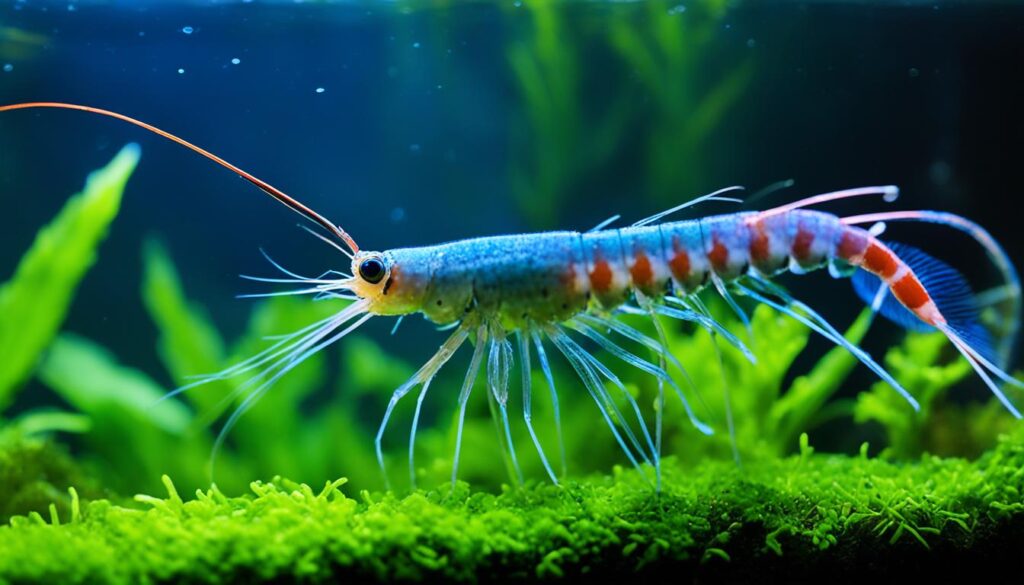
| Key Features | Benefits |
|---|---|
| Nimble-fingered algae eater | Effectively cleans black beard algae, hair algae, and other types of algae |
| Low-maintenance | Does not require extensive care or special attention |
| Peaceful nature | Can coexist with a variety of fish species |
| Efficient algae control | Helps maintain a clean and balanced aquarium environment |
“Amano Shrimp are highly effective at controlling black beard algae and hair algae in aquariums. With their nimble fingers, they can reach into narrow gaps and tear off chunks of fuzzy algae. By incorporating a group of at least four Amano Shrimp into your tank, you can make a significant impact on algae growth.” – Expert Aquarist
Nerite Snails
Nerite Snails are small, ornamental snails that excel in keeping your aquarium clean and free from algae. These scavenging snails are highly effective at consuming and eradicating unwanted green spot algae that can accumulate on plants, driftwood, and decor. With their voracious appetite for algae, Nerite Snails act as excellent plant cleaners, ensuring a pristine and visually appealing aquatic environment.
One of the advantages of Nerite Snails is that they do not reproduce in freshwater, unlike other snail species. This means you don’t have to worry about your tank being overrun by snail populations. Choose from a variety of beautiful Nerite Snail varieties, such as tiger, zebra, horned, and red racer, to add visual interest to your aquarium. If you prefer a hardy option, consider olive nerite snails, known for their resilience and adaptability.
When it comes to maintaining healthy shell development in Nerite Snails, it’s crucial to provide them with additional calcium. This can be achieved by offering calcium-rich foods, such as blanched vegetables, crushed cuttlebone, or specialized snail food. Ensuring a proper calcium supply will contribute to the overall well-being and lifespan of your Nerite Snails.
Cherry Shrimp
When it comes to algae control in your aquarium, Cherry Shrimp, also known as Neocaridina davidi, offer a colorful and lively solution. These dwarf shrimp may not be the most efficient algae eaters, but they make up for it with their ability to breed easily in home aquariums. With a decent-sized colony, Cherry Shrimp can provide excellent preventative maintenance against the buildup of excess food and algae.
Despite their small size, Cherry Shrimp have tiny limbs that are perfect for picking through the substrate, plant roots, and crevices. They diligently graze on algae, preventing it from taking over your aquarium. These vibrant shrimp come in a variety of hues, including red, orange, yellow, blue, and more, adding a delightful touch to your aquatic environment.
One of the advantages of keeping Cherry Shrimp is their breeding ability. Females can carry hundreds of eggs, and they breed readily in home aquariums under the right conditions. This means you can quickly grow your shrimp population and even use them as a source of income by selling or trading them with other hobbyists.
It is essential to provide a well-balanced diet for Cherry Shrimp. While they can sustain themselves with algae, supplementing their diet with high-quality shrimp-specific food ensures their overall health and vitality. Additionally, maintaining clean water conditions and avoiding the use of chemicals that may harm shrimp is important for their well-being.
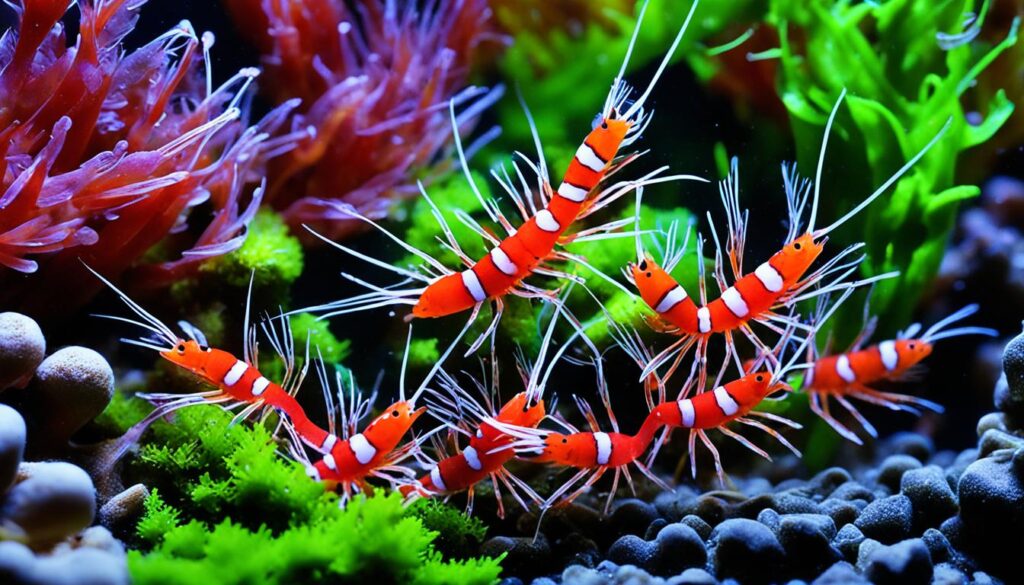
Cherry Shrimp are an incredible addition to any aquarium, offering both aesthetic appeal and practical benefits in terms of algae control. Whether you are a beginner or an experienced aquarist, these colorful, breedable dwarf shrimp can be a fascinating and rewarding choice for your aquatic ecosystem.
Otocinclus Catfish
When it comes to efficient algae control in your aquarium, the Otocinclus Catfish, also known as otos or dwarf suckermouths, is a standout choice. These small catfish, staying around 2 inches in length, are specifically adapted for grazing on diatom algae, which commonly coats flat surfaces such as aquarium glass and plant leaves. Their smaller, slender bodies allow them to navigate tighter spaces than other algae-eating fish, making them ideal for reaching those hard-to-reach areas.
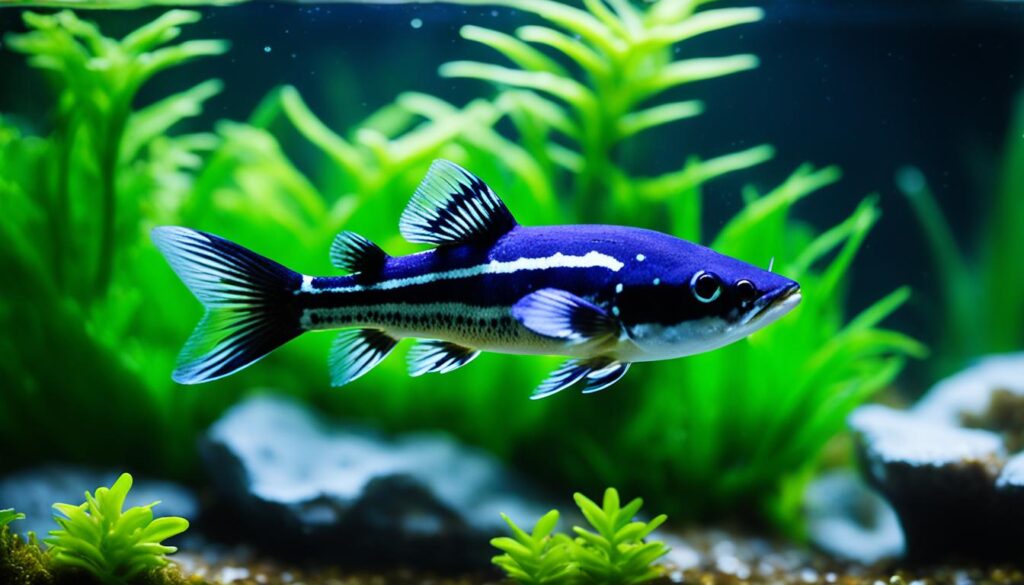
However, it’s important to note that Otocinclus Catfish are prone to being underfed. To ensure their well-being, a nutritious diet is crucial. I recommend providing them with plenty of Repashy Soilent Green, a high-quality vegetable-based food, and supplementing their diet with fresh vegetables. By providing them with a well-rounded diet, you can help them thrive and ensure their ability to keep those diatom algae under control.
Group Care
These catfish are naturally social creatures, so it’s best to keep them in groups of three to six individuals. Group care allows them to feel safe and comfortable in their environment, resulting in healthier and more active fish. Creating a harmonious group dynamic can be achieved by providing plenty of hiding places and suitable aquarium companions.
Summarized Care Tips:
- Provide a nutritious diet with Repashy Soilent Green and vegetables.
- Keep them in groups of three to six individuals for a healthier and more active environment.
- Ensure adequate hiding places to create a sense of security.
Siamese Algae Eater
When it comes to algae control in your aquarium, the Siamese Algae Eater is a reliable and efficient option. Known for its ability to consume various types of algae, including hair algae and black beard algae, this fish can help keep your tank clean and pristine.
The Siamese Algae Eater is a peaceful species that is relatively easy to care for. However, as they mature, they may become lazy and start to prefer fish food over algae. To encourage them to eat algae again, it is recommended to reduce their food portion sizes and provide a diet that promotes their natural foraging behavior.
This species can be territorial, especially with their own or similar-looking species, so it is advisable to keep them in a group of three or more. This not only enhances their ability to control algae but also ensures a more harmonious environment for them to thrive in.
The Siamese Algae Eater at a glance:
| Tank Size | pH Level | Temperature | Care Level | Compatibility |
|---|---|---|---|---|
| 20+ gallons | 6.5 – 7.5 | 75 – 79°F | Easy | Peaceful with most fish |
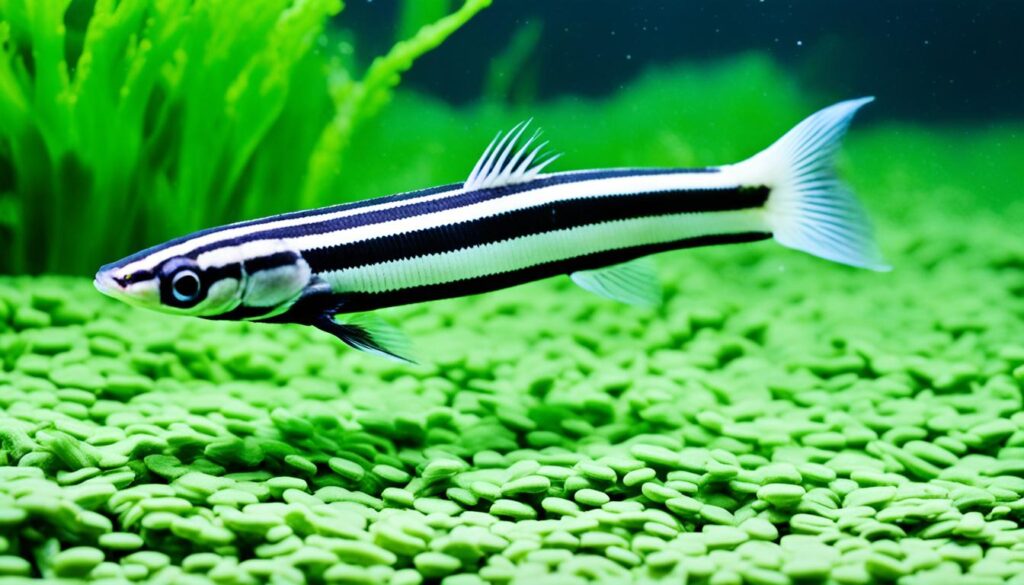
“The Siamese Algae Eater is a dependable algae control solution that can help maintain a healthy and visually appealing aquarium.”
Adding Siamese Algae Eaters to your tank can significantly enhance algae control, allowing your fish and plants to thrive in a clean and balanced ecosystem.
Florida Flagfish
When it comes to controlling algae in your aquarium, the Florida Flagfish, also known as the American flagfish, is a top choice. These voracious algae eaters have a particular taste for hair algae and other fuzzy types of algae, making them an effective solution for keeping your tank clean and algae-free.
Florida Flagfish are best suited for unheated tanks with other fast-swimming tank mates. Their distinctive red stripes add a beautiful touch to any aquarium, creating a visually appealing display. With a minimum tank size of 20 gallons, these fish thrive in cooler water environments without the need for aquarium heaters.
Here are some key characteristics and considerations for the Florida Flagfish:
- Voracious algae eaters, with a particular preference for hair/thread algae
- Best suited for unheated tanks
- Thrives in cooler water environments
- Minimum tank size of 20 gallons
- Distinctive red stripes add beauty to the aquarium
If you’re looking for an effective algae eater to keep your tank clean and free from hair/thread algae, the Florida Flagfish is a great choice. With their unique appearance and impressive algae-eating abilities, these fish are sure to be a valuable addition to your aquarium.
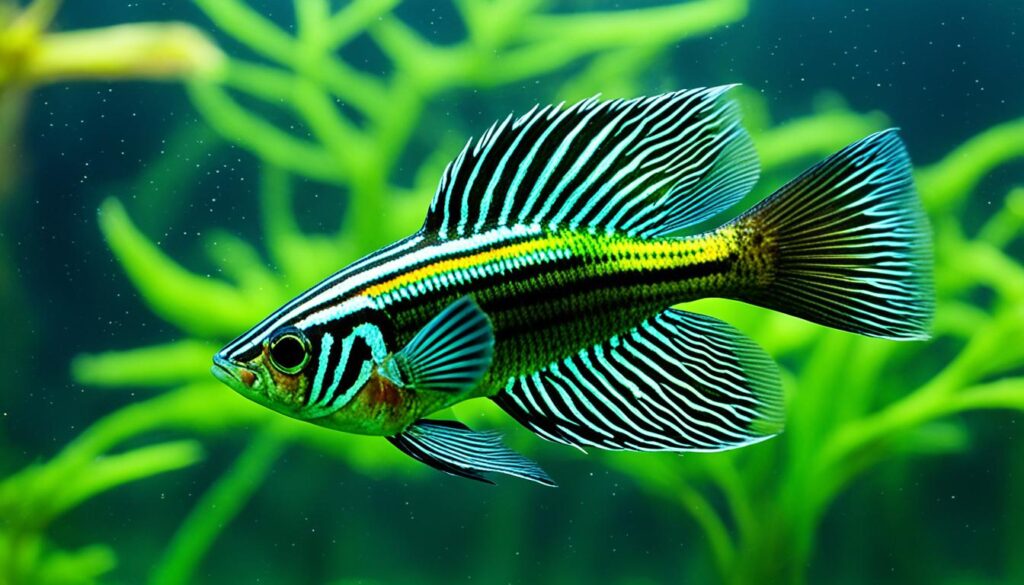
Bristlenose Plecostomus
Bristlenose Plecostomus, from the Ancistrus genus, are peaceful catfish that stay between 4 to 5 inches in length. They are known for their suckermouths, which are perfect for devouring algae, vacuuming up food crumbs, and keeping driftwood clean. They are compatible with most peaceful species and tolerate a range of tank conditions. However, it is important to feed them a well-rounded diet of sinking wafers, frozen bloodworms, and Repashy gel food to ensure they get all the necessary nutrients.
These small catfish have distinct bristly tentacles on their snouts, giving them their name. They use these tentacles to navigate and explore the aquarium, searching for tasty morsels and detritus to feast on. Their ability to remove algae from various surfaces, including the glass, rocks, and plants, makes them excellent algae eaters.
While Bristlenose Plecostomus are proficient algae eaters, they should not be solely relied upon for algae control. Supplement their diet with quality sinking pellets or wafers formulated specifically for bottom-dwelling fish. Additionally, offering blanched vegetables like zucchini or cucumber can provide much-needed roughage and aid in digestion.
If you have driftwood in your aquarium, the Bristlenose Plecostomus will happily clean its surface. They use their rasping mouthparts to scrape off any organic matter or algae that may accumulate over time. This behavior not only helps keep the driftwood looking clean and natural but also promotes a healthier aquarium environment.
Compatibility and Tankmates
Bristlenose Plecostomus are generally peaceful and get along well with other peaceful fish species. They can be kept in community tanks with a variety of fish, such as tetras, rasboras, gouramis, and livebearers. Avoid housing them with aggressive or territorial fish that may harass or outcompete them for food.
These catfish are hardy and adaptable to different water conditions. However, it is important to maintain good water quality by performing regular water changes and monitoring ammonia, nitrite, and nitrate levels. They prefer a slightly acidic to neutral pH range of 6.5 to 7.5 and a temperature between 72 to 82°F (22 to 28°C).
Tank Setup and Maintenance
Creating a suitable environment for Bristlenose Plecostomus involves providing them with ample hiding spots, caves, and plenty of driftwood. They are nocturnal by nature and appreciate dark hiding places during the day. The addition of plants, rocks, and other decorations can further enhance their habitat and provide additional surfaces for algae growth and forage.
Regular maintenance is necessary to ensure the well-being of Bristlenose Plecostomus and the longevity of your aquarium. Keep up with water changes, gravel siphoning, and filter maintenance to prevent the accumulation of waste and maintain optimal water parameters.
Overall, the Bristlenose Plecostomus is an excellent choice for aquarists seeking an effective algae eater and a visually striking addition to their aquarium. Their unique appearance, peaceful demeanor, and algae-cleaning abilities make them a valuable asset to any freshwater tank.

Molly Fish
Molly Fish, from the Poecilia genus, are popular livebearers with a knack for picking at algae found on plants, hardscape, and flat surfaces in the aquarium. While they may not be the most efficient algae eaters, they contribute to preventing the buildup of excess food and algae with their constant grazing. They come in various colors, patterns, fin types, and body shapes, making them an attractive addition to any aquarium. It is important to note that some mollies are raised in brackish water fish farms, so extra care may be needed to ensure their health.
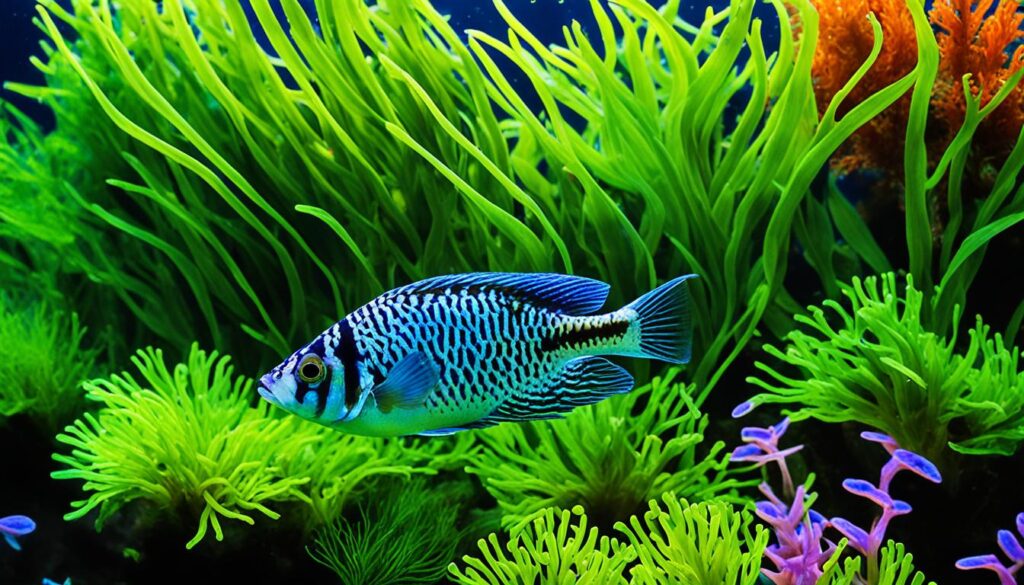
Rosy Barb
When it comes to controlling fuzzy algae like hair algae, black beard algae, and thread algae in your aquarium, the Rosy Barb (Pethia conchonius) is a top choice. These vibrant and peaceful fish have a natural appetite for various types of algae, making them excellent fuzzy algae eaters.
Rosy Barbs are well-suited for unheated aquariums, and they can thrive alongside other fast-swimming tank mates. To ensure a balanced and active schooling behavior, it is recommended to keep them in groups of at least 6 to 10 individuals.
“Rosy Barbs are a great addition to aquariums struggling with certain types of algae.”
With their striking colors and active nature, Rosy Barbs not only help control algae but also add beauty to your aquatic setup. Consider adding these fuzzy algae eaters to your unheated aquarium for a clean and visually appealing environment.

Key Features of Rosy Barb:
- Natural appetite for fuzzy algae
- Peaceful and compatible with other fish
- Suitable for unheated aquariums
- Active schooling behavior
- Striking colors and vibrant appearance
Conclusion
Algae control is crucial for ensuring a clean and healthy environment in your aquarium. The top 7 freshwater invertebrates discussed in this article provide effective solutions for tackling various types of algae, including flat surfaces, fuzzy algae, and thread-like algae. From the unique Reticulated Hillstream Loach to the nimble-fingered Amano Shrimp, and the hardworking Nerite Snails, these algae-eating invertebrates offer natural and efficient methods for keeping your tank free from unsightly algae growth.
Not to be overlooked are the Otocinclus Catfish, Siamese Algae Eater, Florida Flagfish, and Bristlenose Plecostomus, each with their own algae-munching specialties. Additionally, the Cherry Shrimp, Molly Fish, and Rosy Barb play vital roles in preventing excess food and algae buildup, contributing to a balanced and visually appealing aquarium ecosystem.
When selecting your algae control team, it is important to consider the specific needs and compatibility of each species. By adding a combination of these top freshwater invertebrates to your aquarium, you can ensure a clean and healthy aquatic environment for your fish while enjoying the beauty they bring to your underwater world.
FAQ
Why is algae control important in an aquarium?
Algae can quickly turn your underwater world into an unsightly mess, affecting the health and appearance of your fish tank. Algae control is essential for maintaining a clean and healthy aquarium environment.
What are the top freshwater invertebrates for algae control?
The top freshwater invertebrates for algae control are the Reticulated Hillstream Loach, Amano Shrimp, Nerite Snails, Cherry Shrimp, Otocinclus Catfish, Siamese Algae Eater, Florida Flagfish, Bristlenose Plecostomus, Molly Fish, and Rosy Barb. These invertebrates excel at controlling various types of algae in an aquarium.
What is a Reticulated Hillstream Loach?
Reticulated Hillstream Loach is a unique and visually striking algae eater that can clean large, flat surfaces such as vertical aquarium walls, rocks, and broad plant leaves. They are like personal window washers for diatoms and other flat types of algae.
How do Amano Shrimp contribute to algae control?
Amano Shrimp are nimble-fingered algae eaters that can reach into narrow gaps or tear off chunks of fuzzy algae. They are known to eat black beard algae and hair algae, making them an effective natural control method.
What are Nerite Snails good at?
Nerite Snails are small, ornamental snails that are adept at both scavenging and consuming algae. They are especially useful in scraping off tough green spot algae found on plants, driftwood, and decor.
How do Cherry Shrimp help with algae control?
Cherry Shrimp are brightly colored dwarf shrimp that can pick at algae found on plants, hardscape, and flat surfaces in the aquarium. While they may not be the most efficient algae eaters, they contribute to preventing the buildup of excess food and algae with their constant grazing.
What is special about Otocinclus Catfish?
Otocinclus Catfish, also known as otos or dwarf suckermouths, have smaller, slender bodies that allow them to fit into tighter spaces than other algae-eating fish. They eat diatom algae from flat surfaces such as aquarium glass or plant leaves.
Why are Siamese Algae Eaters popular for algae control?
Siamese Algae Eaters are effective at eating a variety of algae, including hair algae and black beard algae. They can be kept in a group of three or more for better algae-eating power.
How do Florida Flagfish contribute to algae control?
Florida Flagfish, also known as the American flagfish, have a particular taste for hair algae and other fuzzy types of algae. They can be kept in unheated tanks with other fast-swimming tank mates.
What is special about Bristlenose Plecostomus?
Bristlenose Plecostomus, from the Ancistrus genus, have suckermouths that are perfect for devouring algae, vacuuming up food crumbs, and keeping driftwood clean. They are compatible with most peaceful species and tolerate a range of tank conditions.
How do Molly Fish contribute to algae control?
Molly Fish, from the Poecilia genus, have a knack for picking at algae found on plants, hardscape, and flat surfaces in the aquarium. They contribute to preventing the buildup of excess food and algae with their constant grazing.
What is special about Rosy Barbs?
Rosy Barbs, particularly the Pethia conchonius species, have a taste for fuzzy algae like hair algae, black beard algae, and thread algae. They can be kept in unheated aquariums with other fast-swimming tank mates.
